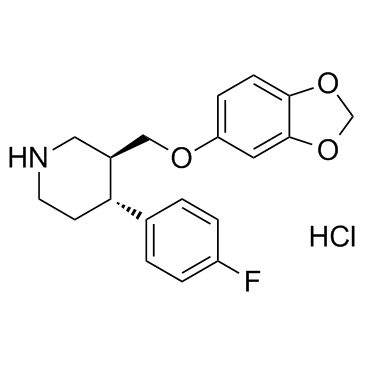78246-49-8
| Name | Paroxetine Hydrochloride |
|---|---|
| Synonyms |
MFCD00797405
(3S,4R)-3-[(1,3-Benzodioxol-5-yloxy)methyl]-4-(4-fluorophenyl)piperidine hydrochloride Paroxetine HCl Paroxetine Hydrochloride piperidine, 3-[(1,3-benzodioxol-5-yloxy)methyl]-4-(4-fluorophenyl)-, (3S,4R)-, hydrochloride Piperidine, 3-[(1,3-benzodioxol-5-yloxy)methyl]-4-(4-fluorophenyl)-, (3S,4R)-, hydrochloride (1:1) (3S,4R)-3-[(1,3-Benzodioxol-5-yloxy)methyl]-4-(4-fluorophenyl)piperidine hydrochloride (1:1) |
| Description | Paroxetine hydrochloride is a potent selective serotonin-reuptake inhibitor, commonly prescribed as an antidepressant and has GRK2 inhibitory ability with IC50 of 14 μM. |
|---|---|
| Related Catalog | |
| Target |
IC50: 14 μM (GRK2)[3] |
| In Vitro | Paroxetine (1 μM and 10 μM) distinctly restrains T cell migration induced by CX3CL1 through inhibiting GRK2. Paroxetine inhibits GRK2 induced activation of ERK[1]. Paroxetine (10 μM) reduces pro-inflammatory cytokines in LPS-stimulated BV2 cells. Paroxetine (0-5 μM) leads to a dose-dependent inhibition on LPS-induced production of TNF-α and IL-1β in BV2 cells. Paroxetine also inhibits lipopolysaccharide (LPS)-induced nitric oxide (NO) production and inducible nitric oxide synthase (iNOS) expression in BV2 cells. Paroxetine (5 μM) blocks LPS-induced JNK activation and attenuates baseline ERK1/2 activity in BV2 cells. Paroxetine relieves microglia-mediated neurotoxicity, and suppresses LPS-stimulated pro-inflammatory cytokines and NO in primary microglial cells[4]. |
| In Vivo | Paroxetine treatment obviously attenuates the symptoms of CIA rats. Paroxetine treatment clearly prevents the histological damage of joints and alleviates T cells infiltration into synovial tissue. Paroxetine reveals a strong effect on inhibiting CX3CL1 production in synovial tissues[1]. Paroxetine (20 mg/kg/day) reduces the myocyte cross-sectional area in rat and ROS formation in the remote myocardium. Paroxetine reduces the susceptibility to ventricular tachycardia. Paroxetine treatment following MI decreases LV remodeling and susceptibility to arrhythmias, probably by reducing ROS formation[2]. In CCI paroxetine-treated group, paroxetine (10 mg/kg, i.p.) produces hyperalgesia at days 7 and 10 (P<0.01), but a decrease in pain behavior is seen at day 14. Moreover, paroxetine (10 mg/kg) significantly attenuates tactile hypersensitivity when compared to CCI vehicle-treated group[5]. |
| Cell Assay | Cell viability is determined by the tetrazolium salt 3-[4,5-dimethylthiazol-2-yl]-2,5-diphenyltetrazolium bromide (MTT) assay. BV2 and primary microglial cells are initially seeded into 96-well plates at a density of 1×104 cells/well and 5×104 cells/well, respectively. Following treatment, MTT (5 mg/mL in PBS) is added to each well and incubated at 37°C for four hours. The resulting formazan crystals are dissolved in dimethylsulfoxide (DMSO). The optical density is measured at 570 nm, and results are expressed as a percentage of surviving cells compared with the control. |
| Animal Admin | Animals are divided into two main groups: 1) pre-emptive and 2) post-injury group. Each main group is divided into three different subgroups: I) CCI vehicle-treated group, II) sham group, and III) CCI paroxetine-treated group. Vehicle is injected i.p. to CCI and sham-operated animals. In the pre-emptive study, paroxetine (10 mg/kg) is injected 1 h before surgery and continued daily until day 14 post surgery. In the post-injury group, paroxetine (10 mg/kg) is administered at day 7 post injury and continued daily until day 14. All behavioral tests are recorded on day 0 (control day) before surgery and on days 1, 3, 5, 7, 10, and 14 post-nerve injury. |
| References |
| Density | 1.213 g/cm3 |
|---|---|
| Boiling Point | 451.7ºC at 760 mmHg |
| Melting Point | 129-131ºC |
| Molecular Formula | C19H21ClFNO3 |
| Molecular Weight | 365.826 |
| Flash Point | 227ºC |
| Exact Mass | 365.119385 |
| PSA | 39.72000 |
| LogP | 4.45730 |
| Storage condition | -20°C Freezer |
CHEMICAL IDENTIFICATION
HEALTH HAZARD DATAACUTE TOXICITY DATA
|
| RIDADR | UN 3249 |
|---|---|
| Packaging Group | III |
| Hazard Class | 6.1(b) |
| HS Code | 2934999090 |
| HS Code | 2934999090 |
|---|---|
| Summary | 2934999090. other heterocyclic compounds. VAT:17.0%. Tax rebate rate:13.0%. . MFN tariff:6.5%. General tariff:20.0% |
